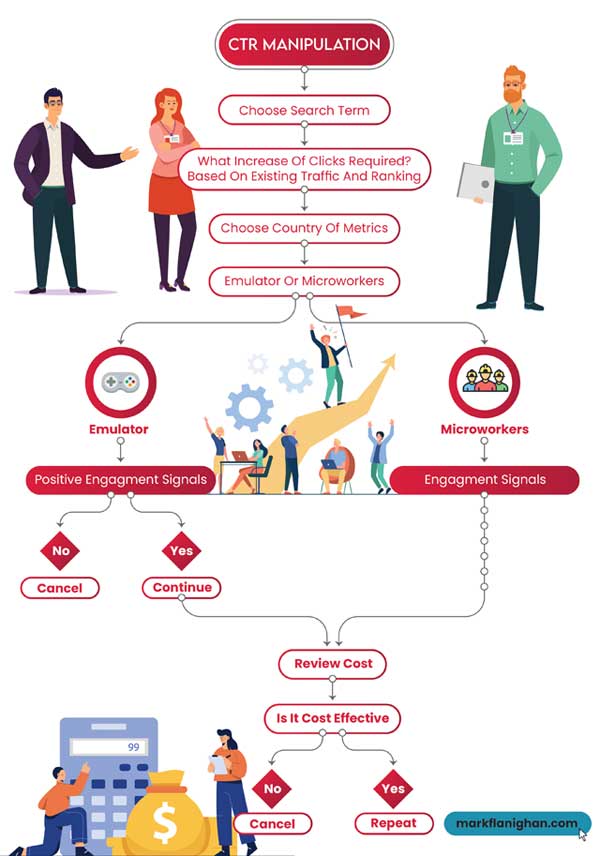Why You Ought to Invest in a Comprehensive CTR Manipulation Service
Accomplishing Success With Targeted CTR Manipulation
The optimization of click-through prices (CTR) is a vital undertaking for brands aiming to improve their digital presence and make the most of involvement. Targeted CTR adjustment includes a variety of techniques, from data-driven advertisement positionings to the growth of compelling web content customized to particular target markets. Understanding the nuances of user habits and employing techniques such as A/B screening can considerably influence efficiency results. Nonetheless, the trip to understanding these strategies is intricate and needs a continuous dedication to evaluation and improvement. The question continues to be: what particular methods will produce one of the most significant cause this dynamic landscape?
Understanding Click-Through Fees
Click-through rates (CTR) work as an essential metric in electronic advertising, showing the performance of online material in driving customer engagement. This metric is calculated by separating the variety of clicks a promotion or link gets by the total variety of impacts, shared as a percentage (CTR Manipulation). A higher CTR shows that the material reverberates well with the target market, motivating them to take action
Understanding CTR is necessary for marketing professionals aiming to maximize their projects. Different factors affect CTR, consisting of ad placement, style, and the significance of the content to the audience's passions. As an example, compelling headlines and aesthetically appealing pictures can significantly enhance the chance of users clicking a link.
Furthermore, the context in which the web content is offered plays a vital function in establishing CTR. Eventually, a complete understanding of CTR encourages marketers to refine their approaches, guaranteeing that digital campaigns achieve their preferred outcomes effectively.
Relevance of CTR Control
In the competitive landscape of electronic advertising, the control of click-through rates (CTR) has become a vital method for enhancing project efficiency. CTR acts as an essential performance indicator, reflecting the performance of on the internet advertisements and material in bring in customer involvement. A greater CTR not only indicates higher rate of interest but additionally can lead to boosted online search engine rankings and reduced cost-per-click (CPC) rates, thereby enhancing total advertising budget plans.
The value of CTR manipulation lies in its capacity to inform marketing experts regarding client choices and habits. By analyzing CTR information, companies can recognize which elements of their projects reverberate most with their target audience. This understanding permits for more educated decision-making and the appropriation of resources to the most efficient channels.
Moreover, effective CTR adjustment cultivates an affordable benefit. Brand names that constantly accomplish greater CTRs can beat competitors, protecting an extra substantial market visibility. In an era where customer focus is short lived, capturing clicks translates directly to raised leads and conversions, ultimately driving business growth. Therefore, understanding CTR adjustment is not simply helpful; it is essential for achieving sustained success in electronic advertising and marketing efforts.
Methods for Targeted CTR
Attaining targeted click-through rates (CTR) calls for a tactical strategy that includes different strategies customized to certain target market segments. One reliable strategy is enhancing ad placements by utilizing data analytics to identify high-performing networks. By focusing efforts on these channels, marketers can boost exposure and increase involvement.
One more critical technique is crafting compelling headlines and calls to action (CTAs) A/B screening different variants can disclose which combinations reverberate most with the target market, thus driving higher directory CTR. Additionally, including aesthetic aspects such as captivating images or videos can considerably improve appeal, making content a lot more appealing and shareable.
Personalization additionally plays a crucial duty; making use of user data to create tailored web content can foster a feeling of relevance, motivating clicks. Additionally, leveraging social proof via reviews and user-generated web content can construct trust, eventually enhancing CTR.
Analyzing Individual Actions
 Understanding customer behavior is vital for enhancing marketing strategies and enhancing general efficiency. By evaluating how users interact with web content, online marketers can obtain useful understandings right into choices, inspirations, and discomfort points. This expertise makes it possible for the growth of more targeted campaigns that reverberate with certain target market sectors.
Understanding customer behavior is vital for enhancing marketing strategies and enhancing general efficiency. By evaluating how users interact with web content, online marketers can obtain useful understandings right into choices, inspirations, and discomfort points. This expertise makes it possible for the growth of more targeted campaigns that reverberate with certain target market sectors.To efficiently analyze individual behavior, different tools and techniques can be utilized. Internet analytics platforms supply data on individual engagement metrics such as click-through prices, bounce prices, and time invested in web page. Heatmaps and session recordings permit marketers to picture customer interactions, exposing which elements draw in interest and which might be ignored.
Furthermore, customer feedback via surveys and responses forms can use qualitative insights, boosting the understanding of user belief and fulfillment. Segmenting individuals based upon demographics, rate of interests, and habits can even more refine targeting efforts, customizing content to satisfy varied needs.
Eventually, constant evaluation of individual habits is crucial for adjusting advertising approaches in real-time. As user trends evolve, remaining in harmony with these changes makes sure that projects continue to be relevant and efficient, promoting a deeper connection with the target market. This fundamental understanding establishes the stage for the successful execution of targeted CTR manipulation techniques.
Measuring Success and Changing Techniques
Determining success in targeted marketing projects calls for a calculated strategy that incorporates efficiency metrics with recurring analysis. Key efficiency signs (KPIs) such as click-through prices (CTR), conversion rates, and consumer purchase costs should be monitored constantly to assess the effectiveness of control methods. By establishing a baseline, online marketers can analyze modifications in CTR and recognize patterns that indicate successful engagement or possible drawbacks.
Routinely assessing these metrics permits the prompt modification of methods. If a certain project shows a significant drop in CTR, it may indicate the demand for creative revisions or a reevaluation of targeting parameters. Using A/B testing can even more improve strategies by contrasting variants of advertisements or landing pages, giving understanding into what resonates finest with the target market.
Furthermore, integrating qualitative comments via studies or individual meetings can supplement quantitative information, providing an extensive sight of audience assumption. Eventually, the capacity to iteratively examine and improve strategies based upon real-time data cultivates a more responsive advertising technique, making sure that projects continue to be lined up with business purposes and target market preferences. This flexible approach is important in achieving continual success in targeted CTR control.
Verdict
Finally, targeted CTR control is necessary for enhancing electronic advertising initiatives. By comprehending click-through rates and employing critical techniques, brands can efficiently boost individual involvement and drive conversions. Constant evaluation of individual habits and diligent measurement of site here performance indicators promote timely adjustments, guaranteeing alignment with consumer choices. Inevitably, effective CTR manipulation not only boosts presence but additionally promotes depend on and trustworthiness, therefore adding to sustained growth in competitive markets.
 Targeted CTR control includes an array of directory techniques, from data-driven ad positionings to the advancement of compelling content tailored to details audiences.Click-through rates (CTR) offer as an essential metric in electronic marketing, showing the performance of on-line content in driving user involvement. A greater CTR shows that the web content resonates well with the target audience, motivating them to take action.
Targeted CTR control includes an array of directory techniques, from data-driven ad positionings to the advancement of compelling content tailored to details audiences.Click-through rates (CTR) offer as an essential metric in electronic marketing, showing the performance of on-line content in driving user involvement. A greater CTR shows that the web content resonates well with the target audience, motivating them to take action.CTR offers as a key performance indication, reflecting the performance of on-line ads and web content in bring in user interaction.In verdict, targeted CTR adjustment is necessary for optimizing electronic marketing initiatives.